Maximum Power Point Tracking Implementation under Partial Shading Conditions Using Low-Cost Photovoltaic Emulator
Abstract
:1. Introduction
- A cascaded structure of a battery-based PV emulation system is suggested for the partial shading conditions. Therefore, complex partial shading conditions can be easily represented.
- Maximum power extraction employing the P&O and PSO techniques.
- Experimental HIL verification of the proposed PV emulator and the MPPT operation.
2. The Model of the PV Source and Proposed Emulation System
2.1. PV System Model
2.2. The Proposed PV Emulator
3. Maximum Power Point Tracking Based P&O and PSO Techniques
3.1. The Perturb-and-Observe Method
3.2. The Particle Swarm Optimization Algorithm
- 1
- The duty cycle is chosen to represent the particles in this formulation, and therefore, they get random values in the beginning. It is worth mentioning that the duty cycle value is bounded between 0 and 1.
- 2
- The values of output power corresponding to the duty cycles are collected and compared together. Thus, the one (duty cycle) with the highest power will attract other particles to its position. Therefore, the position of the particle is influenced by the best particle in the neighborhood.
- 3
- During its journey, the particle will save the best value obtained. This value (power) is called the best private or . Furthermore, the best solution obtained from all particles in the entire population is called the global solution ().
- 4
- Mathematically, the path () or movement speed of each particle (represent the step size) to its new position is updated fromwhere w is the inertia weight, and are the acceleration factors, is the personal best solution of particle i, is the global best position of the particles, and are random numbers, and k is the iteration number.
- 5
- The new position or duty cycle () is simply the addition of the velocity to the current position as
4. Simulation Results
5. Experimental Evaluation
5.1. Set-Up Description
5.2. Experimental Results
6. Further Discussions
6.1. Comparison with Other PV Emulators
6.2. More Complex Partial Shading Conditions
6.3. On the Failure of P&O Method
7. Conclusions
Author Contributions
Funding
Institutional Review Board Statement
Informed Consent Statement
Data Availability Statement
Conflicts of Interest
References
- Muis, Z.A.; Hashim, H.; Manan, Z.A.; Taha, F.M.; Douglas, P.L. Optimal planning of renewable energy-integrated electricity generation schemes with CO2 reduction target. Renew. Energy 2010, 35, 2562–2570. [Google Scholar] [CrossRef] [Green Version]
- Qi, T.; Zhang, X.; Karplus, V.J. The energy and CO2 emissions impact of renewable energy development in China. Energy Policy 2014, 68, 60–69. [Google Scholar] [CrossRef] [Green Version]
- Ayop, R.; Tan, C.W. A comprehensive review on photovoltaic emulator. Renew. Sustain. Energy Rev. 2017, 80, 430–452. [Google Scholar] [CrossRef]
- Ahmed, M.; Abdelrahem, M.; Kennel, R. Highly efficient and robust grid connected photovoltaic system based model predictive control with kalman filtering capability. Sustainability 2020, 12, 4542. [Google Scholar] [CrossRef]
- Salama, H.S.; Kotb, K.M.; Vokony, I.; Dán, A. The Role of Hybrid Battery—SMES Energy Storage in Enriching the Permanence of PV—Wind DC Microgrids: A Case Study. Eng 2022, 3, 16. [Google Scholar] [CrossRef]
- Ram, J.P.; Manghani, H.; Pillai, D.S.; Babu, T.S.; Miyatake, M.; Rajasekar, N. Analysis on solar PV emulators: A review. Renew. Sustain. Energy Rev. 2018, 81, 149–160. [Google Scholar] [CrossRef]
- Chin, V.J.; Salam, Z.; Ishaque, K. Cell modelling and model parameters estimation techniques for photovoltaic simulator application: A review. Appl. Energy 2015, 154, 500–519. [Google Scholar] [CrossRef]
- Jordehi, A.R. Parameter estimation of solar photovoltaic (PV) cells: A review. Renew. Sustain. Energy Rev. 2016, 61, 354–371. [Google Scholar] [CrossRef]
- Humada, A.M.; Hojabri, M.; Mekhilef, S.; Hamada, H.M. Solar cell parameters extraction based on single and double-diode models: A review. Renew. Sustain. Energy Rev. 2016, 56, 494–509. [Google Scholar] [CrossRef] [Green Version]
- Bana, S.; Saini, R.P. A mathematical modeling framework to evaluate the performance of single diode and double diode based SPV systems. Energy Rep. 2016, 2, 171–187. [Google Scholar] [CrossRef]
- Abdelsalam, A.K.; Massoud, A.M.; Ahmed, S.; Enjeti, P.N. High-performance adaptive perturb and observe MPPT technique for photovoltaic-based microgrids. IEEE Trans. Power Electron. 2011, 26, 1010–1021. [Google Scholar] [CrossRef]
- Bhatnagar, P.; Nema, R.K. Maximum power point tracking control techniques: State-of-the-art in photovoltaic applications. Renew. Sustain. Energy Rev. 2013, 23, 224–241. [Google Scholar] [CrossRef]
- Ishaque, K.; Salam, Z. A review of maximum power point tracking techniques of PV system for uniform insolation and partial shading condition. Renew. Sustain. Energy Rev. 2013, 19, 475–488. [Google Scholar] [CrossRef]
- Liu, L.; Meng, X.; Liu, C. A review of maximum power point tracking methods of PV power system at uniform and partial shading. Renew. Sustain. Energy Rev. 2016, 53, 1500–1507. [Google Scholar] [CrossRef]
- Chen, K.; Tian, S.; Cheng, Y.; Bai, L. An improved MPPT controller for photovoltaic system under partial shading condition. IEEE Trans. Sustain. Energy 2014, 5, 978–985. [Google Scholar] [CrossRef]
- Ahmad, R.; Murtaza, A.F.; Sher, H.A.; Shami, U.T.; Olalekan, S. An analytical approach to study partial shading effects on PV array supported by literature. Renew. Sustain. Energy Rev. 2017, 74, 721–732. [Google Scholar] [CrossRef]
- Ahmed, M.; Harbi, I.; Kennel, R.; Abdelrahem, M. Dual-Mode Power Operation for Grid-Connected PV Systems with Adaptive DC-link Controller. Arab. J. Sci. Eng. 2022, 47, 2893–2907. [Google Scholar] [CrossRef]
- Sera, D.; Mathe, L.; Kerekes, T.; Spataru, S.V.; Teodorescu, R. On the perturb-and-observe and incremental conductance MPPT methods for PV systems. IEEE J. Photovolt. 2013, 3, 1070–1078. [Google Scholar] [CrossRef]
- Kermadi, M.; Salam, Z.; Eltamaly, A.M.; Ahmed, J.; Mekhilef, S.; Larbes, C.; Berkouk, E.M. Recent developments of MPPT techniques for PV systems under partial shading conditions: A critical review and performance evaluation. IET Renew. Power Gener. 2020, 14, 3401–3417. [Google Scholar] [CrossRef]
- Manoharan, P.; Subramaniam, U.; Babu, T.S.; Padmanaban, S.; Holm-Nielsen, J.B.; Mitolo, M.; Ravichandran, S. Improved perturb and observation maximum power point tracking technique for solar photovoltaic power generation systems. IEEE Syst. J. 2020, 15, 3024–3035. [Google Scholar] [CrossRef]
- Ayop, R.; Tan, C.W. Rapid prototyping of photovoltaic emulator using buck converter based on fast convergence resistance feedback method. IEEE Trans. Power Electron. 2018, 34, 8715–8723. [Google Scholar] [CrossRef]
- Moussa, I.; Khedher, A.; Bouallegue, A. Design of a low-cost PV emulator applied for PVECS. Electronics 2019, 8, 232. [Google Scholar] [CrossRef] [Green Version]
- Ali, A.N.; Premkumar, K.; Vishnupriya, M.; Manikandan, B.V.; Thamizhselvan, T. Design and development of realistic PV emulator adaptable to the maximum power point tracking algorithm and battery charging controller. Sol. Energy 2021, 220, 473–490. [Google Scholar]
- Merenda, M.; Iero, D.; Carotenuto, R.; Della Corte, F.G. Simple and low-cost photovoltaic module emulator. Electronics 2019, 8, 1445. [Google Scholar] [CrossRef] [Green Version]
- Batzelis, E. Non-iterative methods for the extraction of the single-diode model parameters of photovoltaic modules: A review and comparative assessment. Energies 2019, 12, 358. [Google Scholar] [CrossRef] [Green Version]
- Ahmed, M.; Abdelrahem, M.; Harbi, I.; Kennel, R. An adaptive model-based mppt technique with drift-avoidance for grid-connected PV systems. Energies 2020, 13, 6656. [Google Scholar] [CrossRef]
- Sera, D.; Teodorescu, R.; Rodriguez, P. PV panel model based on datasheet values. In Proceedings of the IEEE International Symposium on Industrial Electronics, Vigo, Spain, 4–7 June 2007; IEEE: Piscataway, NJ, USA, 2007; pp. 2392–2396. [Google Scholar]
- Femia, N.; Petrone, G.; Spagnuolo, G.; Vitelli, M. Optimization of perturb and observe maximum power point tracking method. IEEE Trans. Power Electron. 2005, 20, 963–973. [Google Scholar] [CrossRef]
- Elgendy, M.A.; Zahawi, B.; Atkinson, D.J. Assessment of perturb and observe MPPT algorithm implementation techniques for PV pumping applications. IEEE Trans. Sustain. Energy 2011, 3, 21–33. [Google Scholar] [CrossRef]
- Ishaque, K.; Salam, Z.; Amjad, M.; Mekhilef, S. An improved particle swarm optimization (PSO)—Based MPPT for PV with reduced steady-state oscillation. IEEE Trans. Power Electron. 2012, 27, 3627–3638. [Google Scholar] [CrossRef]
- Ishaque, K.; Salam, Z. A deterministic particle swarm optimization maximum power point tracker for photovoltaic system under partial shading condition. IEEE Trans. Ind. Electron. 2012, 60, 3195–3206. [Google Scholar] [CrossRef]
- Eltamaly, A.M.; Al-Saud, M.S.; Abo-Khalil, A.G. Performance improvement of PV systems’ maximum power point tracker based on a scanning PSO particle strategy. Sustainability 2020, 12, 1185. [Google Scholar] [CrossRef]
- Rezk, H.; Fathy, A.; Abdelaziz, A.Y. A comparison of different global MPPT techniques based on meta-heuristic algorithms for photovoltaic system subjected to partial shading conditions. Renew. Sustain. Energy Rev. 2017, 74, 377–386. [Google Scholar] [CrossRef]
- Nadeem, A.; Sher, H.A.; Murtaza, A.F. Online fractional open-circuit voltage maximum output power algorithm for photovoltaic modules. IET Renew. Power Gener. 2020, 14, 188–198. [Google Scholar] [CrossRef]
- Ahmed, J.; Salam, Z. An improved perturb and observe (P&O) maximum power point tracking (MPPT) algorithm for higher efficiency. Appl. Energy 2015, 150, 97–108. [Google Scholar]
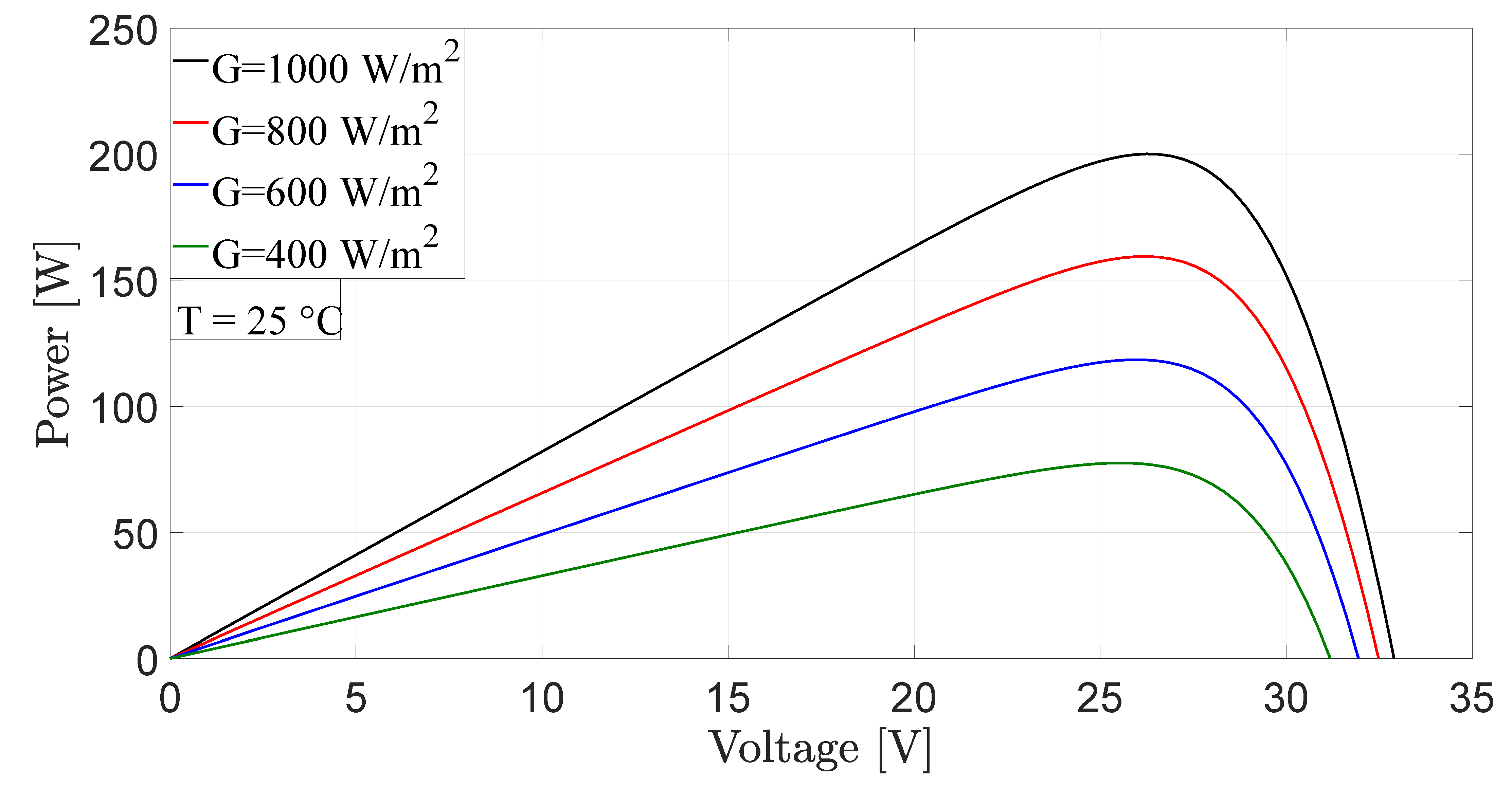



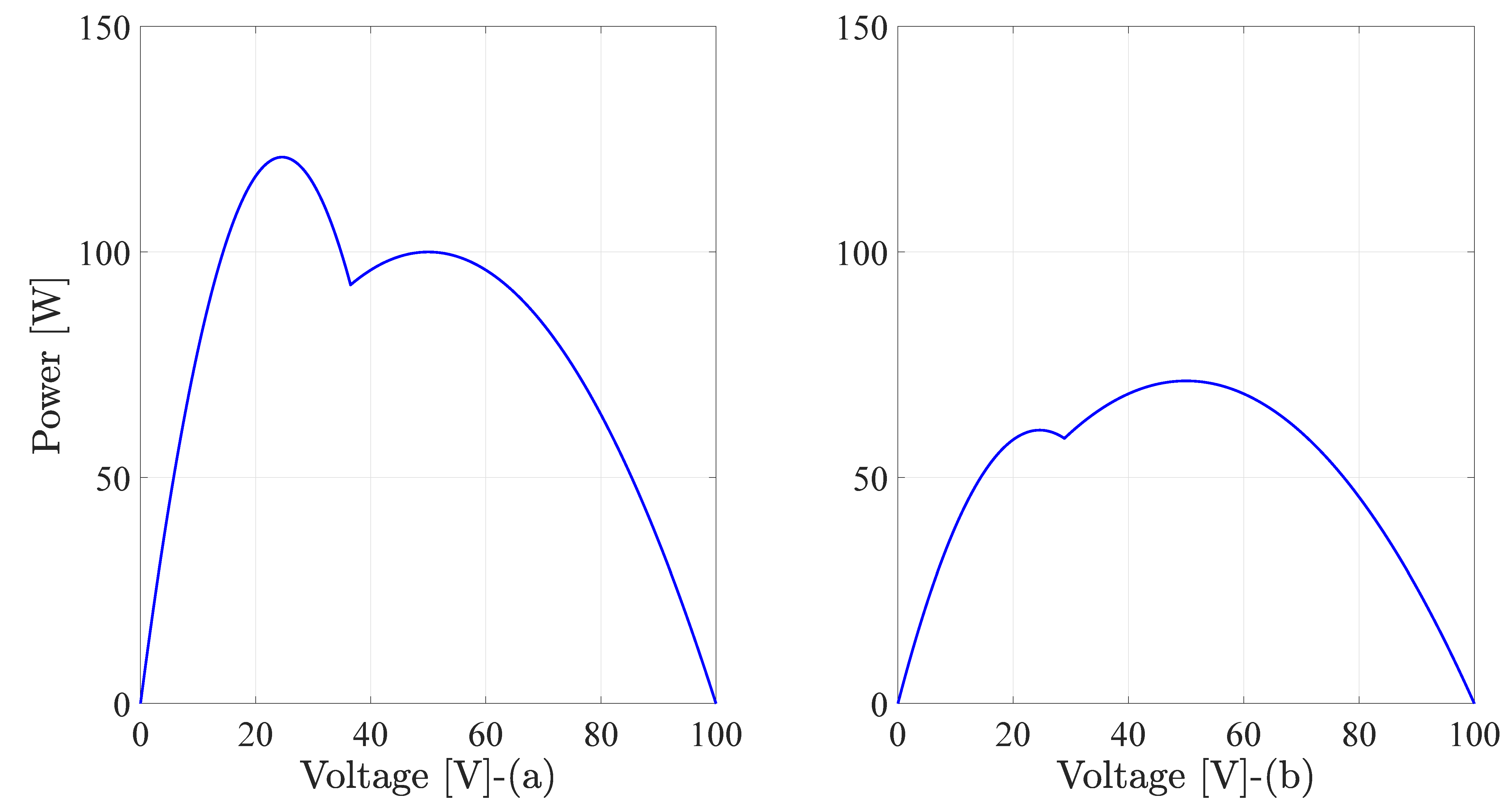

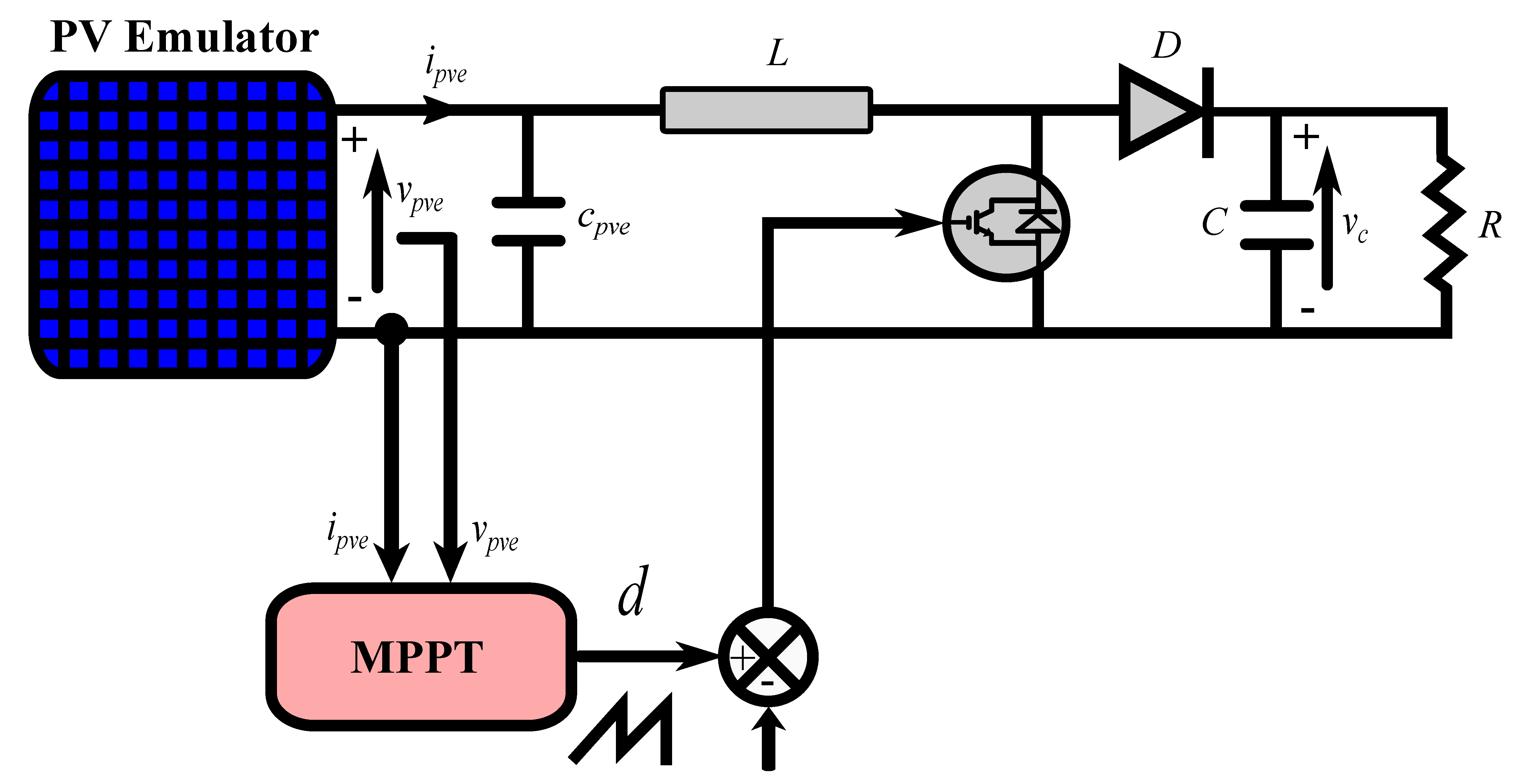
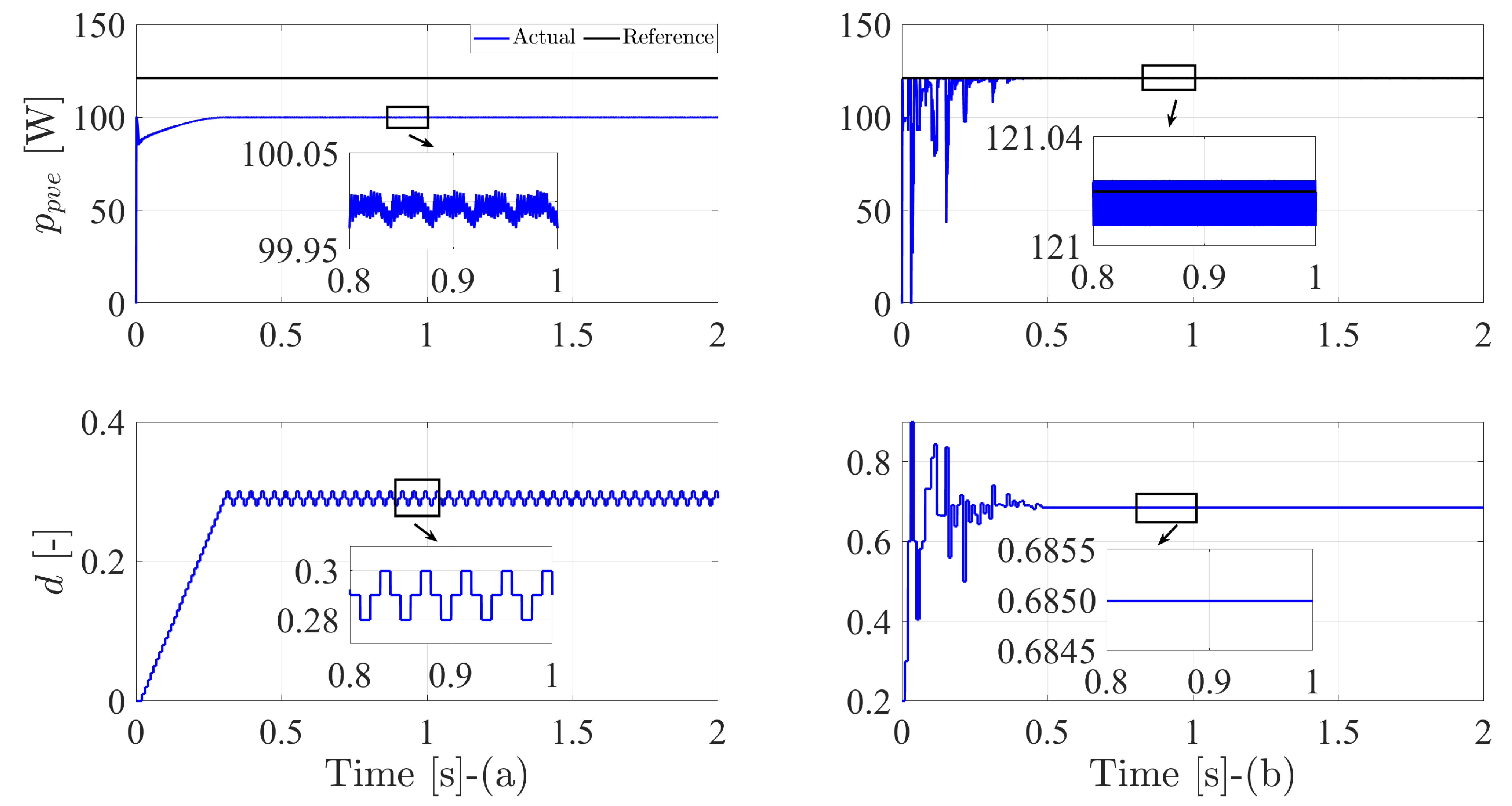




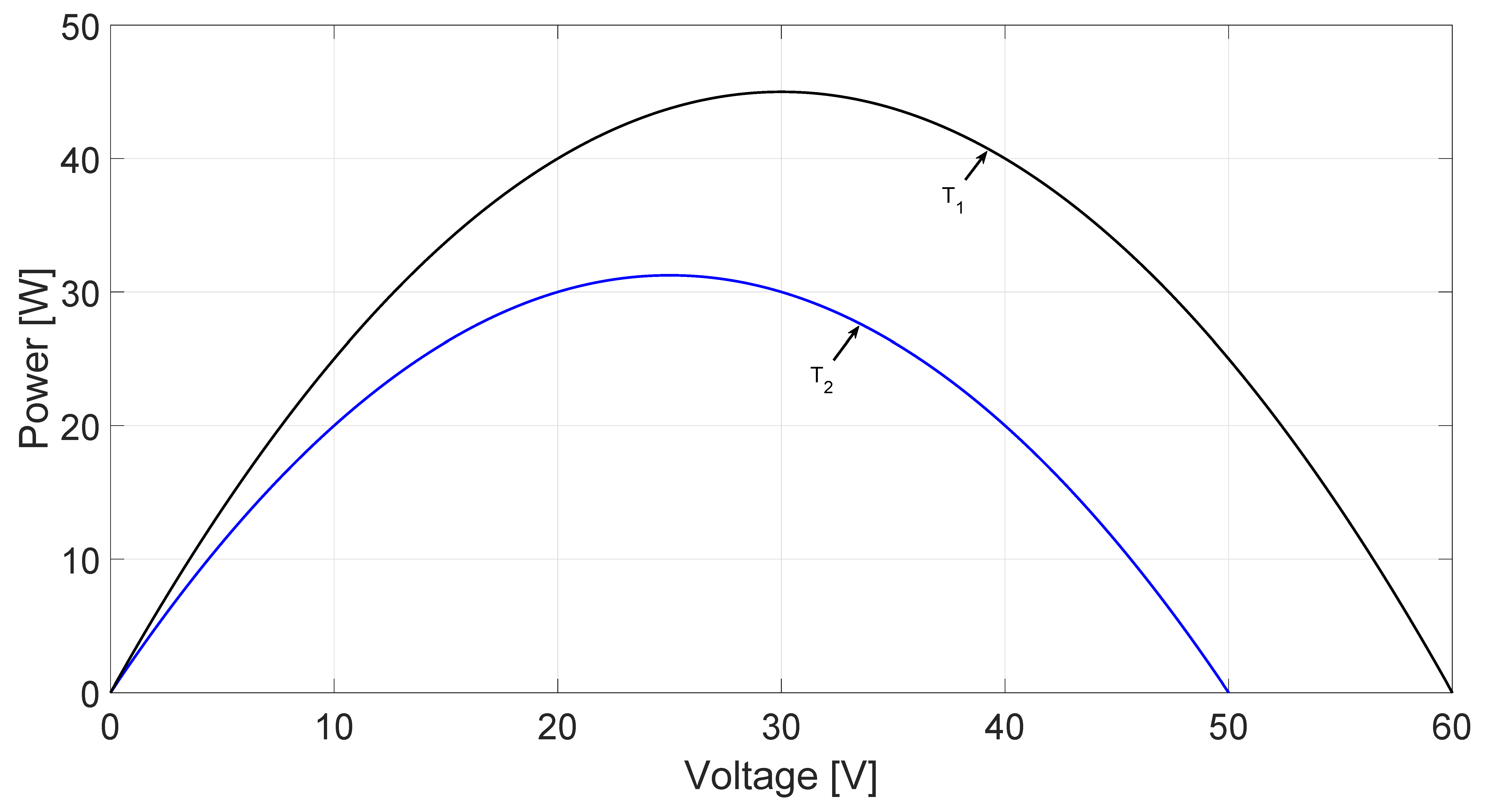

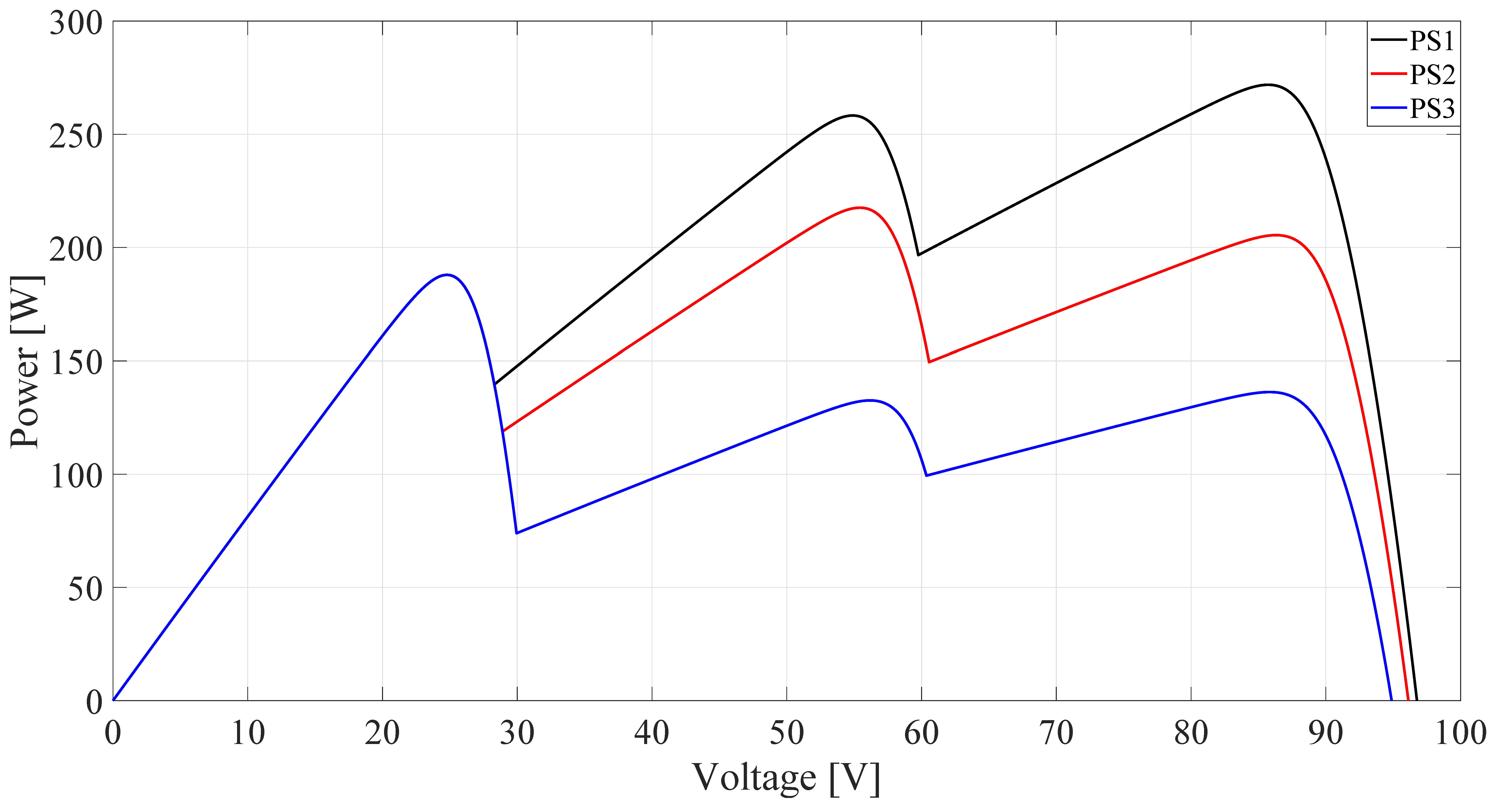


| Parameter | Value |
|---|---|
| Boost inductance | 1 mH |
| Input capacitor | |
| Output capacitor | |
| Load resistance | |
| Switching frequency | 5 kHz |
| MPPT sampling | s |
| Method | (%) |
|---|---|
| P&O | 82.04 |
| PSO | 98.69 |
| Method | Resistive Load, (%) | Battery, (%) |
|---|---|---|
| P&O | 87.47 | 87.43 |
| PSO | 99.85 | 99.89 |
Publisher’s Note: MDPI stays neutral with regard to jurisdictional claims in published maps and institutional affiliations. |
© 2022 by the authors. Licensee MDPI, Basel, Switzerland. This article is an open access article distributed under the terms and conditions of the Creative Commons Attribution (CC BY) license (https://creativecommons.org/licenses/by/4.0/).
Share and Cite
Ahmed, M.; Harbi, I.; Kennel, R.; Abdelrahem, M. Maximum Power Point Tracking Implementation under Partial Shading Conditions Using Low-Cost Photovoltaic Emulator. Eng 2022, 3, 424-438. https://doi.org/10.3390/eng3040031
Ahmed M, Harbi I, Kennel R, Abdelrahem M. Maximum Power Point Tracking Implementation under Partial Shading Conditions Using Low-Cost Photovoltaic Emulator. Eng. 2022; 3(4):424-438. https://doi.org/10.3390/eng3040031
Chicago/Turabian StyleAhmed, Mostafa, Ibrahim Harbi, Ralph Kennel, and Mohamed Abdelrahem. 2022. "Maximum Power Point Tracking Implementation under Partial Shading Conditions Using Low-Cost Photovoltaic Emulator" Eng 3, no. 4: 424-438. https://doi.org/10.3390/eng3040031
APA StyleAhmed, M., Harbi, I., Kennel, R., & Abdelrahem, M. (2022). Maximum Power Point Tracking Implementation under Partial Shading Conditions Using Low-Cost Photovoltaic Emulator. Eng, 3(4), 424-438. https://doi.org/10.3390/eng3040031









